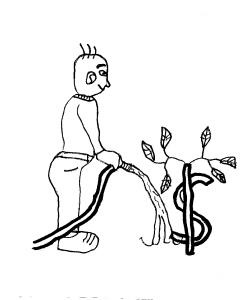
Successful investing is probably 60% psychological and 40% technique. Many teach various investing schemes and repeat the standard bromides. The importance of diversification. Minimizing taxes and transaction costs. The power of compounding and why stocks will do better than bonds over long periods of time. Some will relate the excitement of their various trades. A few will relate stories of some of their failed trades and losses. Few, however, discuss the psychology of successful investing.
Our emotions affect our actions and most people are very emotional about money. Unfortunately, most people are wired exactly backwards to be successful at investing. This is why Las Vegas and a thousand Indian casinos do so well. We tend to put money into stocks when they are nearing a high and pull it out when nearing a bottom. We tend to sell winners quickly, missing out on most of the appreciation, and hold onto losing positions for years, selling when they finally recover to where we bought them.
Because the behavior of the crowd is usually wrong public sentiment is actually measured as a negative indicator. If public sentiment is high and most people are bullish it is time to sell because everyone is fully invested and there is no money left to push prices higher. Conversely, if everyone is bearish there must be a lot of money sitting on the sidelines that can be invested and therefore it is time to buy.
Today I’ll discuss some common psychological traps and how to avoid them.
Holding onto losers too long. Many people will hold onto losing positions, or even average down into losing positions, when they really should just sell the stock. For some reason, people don’t feel that they have taken a loss unless the stock is actually sold. “It’s only a paper loss until you sell,” they’ll say. Often people will hold onto a loss for months or years. If the stock actually does begin to recover and gets back to where they purchased the shares they will sell out. This is usually when the stock goes through the roof.
If you have a losing position, it is best to reevaluate the company. See if there was some mistake in the logic you used when you purchased it. See if something has changed at the company or there was some news of which you were unaware. If you can still find nothing wrong, stick by your guns – it may just be market fluctuations and your stock will eventually recover. If you do find that there was something you missed, accept the mistake, learn from it, sell the stock and move on. If it makes you feel better, realize that you can offset a gain in another stock.
Holding onto winners too short. Many people, when they have a stock that moves up 10 or 20%, will sell the stock. People are fearful of seeing the gain evaporate and becoming a loss. Another way of doing this is setting a stop-loss slightly below the share price and letting the market decide if the stock gets sold. The trouble with this strategy is that stocks are sold just when they are starting their big runs up, so the investor misses out on most of the gain. Because losers tend to be held much too long at the same time winners are sold, many traders never really make much of a profit.
To avoid this, only buy stocks that you feel will do well in the long-term and hold onto them until something at the company changes or the stock gets so outrageously overpriced that it would take years for the earnings to justify the price. Remember that the idea is to make large profits over a period of years, not small profits over a period of months.
Holding onto winners too long. A final mistake is to “fall in love with a stock” and hold onto it even after the business has changed and it will no longer continue to grow. Often, if a stock has gone up and doubled year after year it is difficult to admit that the stock is maturing and it is time to move onto something else.
To avoid this mistake, reevaluate all holdings at least once a year. Ask yourself if it still seems like a fresh young company with plenty of room for growth or if it has filled most of its market and there is little growth left. See if demographics are changing or the company was on a rapid growth path and may have expanded too rapidly. In particular, if a stock has grown substantially under a particular CEO and theat CEO is retiring, it is often time to sell the stock and move on.
Contact me at [email protected], or leave a comment.
Disclaimer: This blog is not meant to give financial planning advice, it gives information on a specific investment strategy and picking stocks. It is not a solicitation to buy or sell stocks or any security. Financial planning advice should be sought from a certified financial planner, which the author is not. All investments involve risk and the reader as urged to consider risks carefully and seek the advice of experts if needed before investing.
